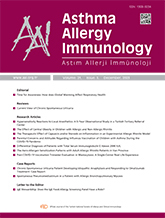


Objective: Although there has been increased attention in recent years to the relationship between allergic disease and obesity, there is limited information about allergic rhinitis (AR) and central obesity. The aim of this study is to investigate the relationship between central obesity and rhinitis severity in patients with rhinitis and controls.
Materials and Methods: A total of 164 children, aged 7-17 years, were included in the study between 2020 and 2021. Three groups were formed: AR, non-allergic rhinitis (NAR), and the control group. The height, weight, waist, hip, neck, and arm circumference of the groups were measured. The BMI, waist-to-hip ratio, waist-to-height ratio, and conicity index were calculated. Eosinophil and neutrophil counts, IgE levels, and allergic sensitization were recorded. Anthropometric measurements, rhinitis severity, and persistence were compared among the groups.
Results: The study included a total of 164 children: 63 with AR, 51 with NAR, and 50 in the control groups of the children included in the study, 71 (43.3%) were boys, and 93 (56.7%) were girls. Approximately 30% of children with normal BMI were evaluated as centrally obese despite having a normal weight. Rhinitis patients had a higher prevalence of central obesity compared to the control group. When comparing both persistence and disease severity, central obesity was higher in AR patients than in NAR patients. The AR group had higher BMI, arm circumference, waist circumference, and neck circumference than the control group (p=0.003, p=0.01, 0.001, 0.004, respectively), while the waist-to-height ratio was higher in both the AR and NAR groups compared to the control group (p=0.001, p=0.026).
Conclusion: In this study, central obesity was significantly higher in patients with AR and NAR than in the control group although there was no significant difference in obesity between the groups according to BMI. Additionally, centrally obese AR patients exhibited higher persistence and disease severity compared to NAR patients. In conclusion, other obesity indicators such as waist circumference should be measured in addition to height and body weight in children with AR and NAR.